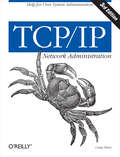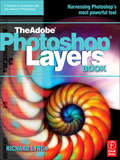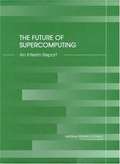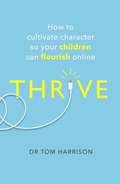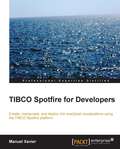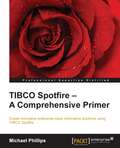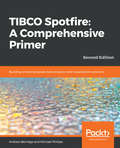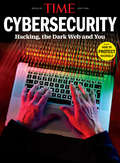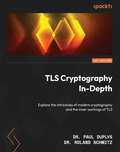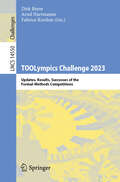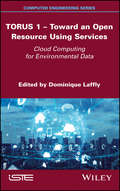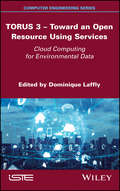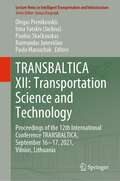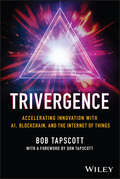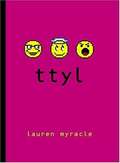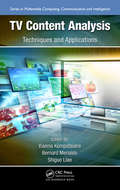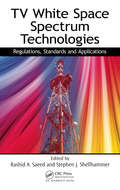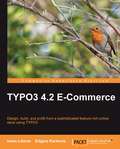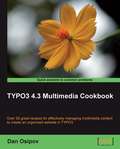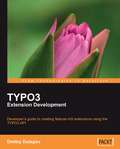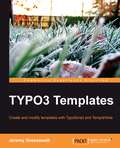- Table View
- List View
TCP/IP Network Administration: Help for Unix System Administrators
by Craig HuntThis complete guide to setting up and running a TCP/IP network is essential for network administrators, and invaluable for users of home systems that access the Internet. The book starts with the fundamentals -- what protocols do and how they work, how addresses and routing are used to move data through the network, how to set up your network connection -- and then covers, in detail, everything you need to know to exchange information via the Internet.Included are discussions on advanced routing protocols (RIPv2, OSPF, and BGP) and the gated software package that implements them, a tutorial on configuring important network services -- including DNS, Apache, sendmail, Samba, PPP, and DHCP -- as well as expanded chapters on troubleshooting and security. TCP/IP Network Administration is also a command and syntax reference for important packages such as gated, pppd, named, dhcpd, and sendmail.With coverage that includes Linux, Solaris, BSD, and System V TCP/IP implementations, the third edition contains:Overview of TCP/IPDelivering the dataNetwork servicesGetting startedMBasic configurationConfiguring the interfaceConfiguring routingConfiguring DNSConfiguring network serversConfiguring sendmailConfiguring ApacheNetwork securityTroubleshootingAppendices include dip, ppd, and chat reference, a gated reference, a dhcpd reference, and a sendmail referenceThis new edition includes ways of configuring Samba to provide file and print sharing on networks that integrate Unix and Windows, and a new chapter is dedicated to the important task of configuring the Apache web server. Coverage of network security now includes details on OpenSSH, stunnel, gpg, iptables, and the access control mechanism in xinetd. Plus, the book offers updated information about DNS, including details on BIND 8 and BIND 9, the role of classless IP addressing and network prefixes, and the changing role of registrars.Without a doubt, TCP/IP Network Administration, 3rd Edition is a must-have for all network administrators and anyone who deals with a network that transmits data over the Internet.
THE ADOBE PHOTOSHOP LAYERS BOOK: Harnessing Photoshop's Most Powerful Tool, Covers Photoshop Cs3
by Richard LynchLayers are the building blocks for working in Photoshop. With the correct use of the Layers Tool, you can edit individual components of your images nondestructively to ensure that your end result is a combination of the best parts of your work. Despite how important it is for successful Photoshop work, the Layers Tool is one of the most often misused and misunderstood features within this powerful software program. This book will show you absolutely everything you need to know to work with layers, including how to use masks, blending, modes and layer management. You'll learn professional techniques as you become completely familiar with the power of layers as an organizational, correction, and revision tool that will quickly become an essential part of your overall Photoshop workflow.
THE FUTURE OF SUPERCOMPUTING: An Interim Report
by Committee on the Future of SupercomputingInformation on THE FUTURE OF SUPERCOMPUTING
THRIVE: How to Cultivate Character So Your Children Can Flourish Online
by Dr Tom HarrisonWinner of the International Federation for Family Development Award.When Dr Tom Harrison, a leading expert in the field of character education and the Internet, bought his daughter her first smartphone, a major milestone had been reached: she had entered the 'cyber-world'. Harrison no longer needed to know what to think; he needed to know what to do. This is the first practical book of its kind to show parents and teachers how to develop character as the foundation for helping young people to thrive in their online interactions. It answers the question: How do we prepare our children to do the right thing when no one is watching?Based on his own experience as a parent, more than a decade of research and thousands of conversations with parents, teachers, children and policymakers, the REACT and THRIVE models have been developed to engage with character, wellbeing, social and emotional learning, ethics and digital citizenship - all the ingredients for flourishing online.The world is waking up to the importance of character for individual and wider societal flourishing. Harrison is at the forefront of this movement and is regularly invited to advise policymakers and thousand of teachers and parents around the world. This book is a must-read for parents and educators who want to help children not just survive but thrive online in their cyber-worlds.
THRIVE: How to Cultivate Character So Your Children Can Flourish Online
by Dr Tom HarrisonWinner of the International Federation for Family Development Award.When Dr Tom Harrison, a leading expert in the field of character education and the Internet, bought his daughter her first smartphone, a major milestone had been reached: she had entered the 'cyber-world'. Harrison no longer needed to know what to think; he needed to know what to do. This is the first practical book of its kind to show parents and teachers how to develop character as the foundation for helping young people to thrive in their online interactions. It answers the question: How do we prepare our children to do the right thing when no one is watching?Based on his own experience as a parent, more than a decade of research and thousands of conversations with parents, teachers, children and policymakers, the REACT and THRIVE models have been developed to engage with character, wellbeing, social and emotional learning, ethics and digital citizenship - all the ingredients for flourishing online.The world is waking up to the importance of character for individual and wider societal flourishing. Harrison is at the forefront of this movement and is regularly invited to advise policymakers and thousand of teachers and parents around the world. This book is a must-read for parents and educators who want to help children not just survive but thrive online in their cyber-worlds.
TI-84 Plus CE Graphing Calculator For Dummies
by Jeff McCallaYou and your trusty TI-84+ can ace math, together Graphing calculators are an essential tool in many high school and college math courses. TI-84 Plus CE Graphing Calculator For Dummies teaches you how to use these handy little machines with confidence, for basic math and far, far beyond. Packed with insider tips, common mistakes to avoid, and updates on the newest products available, this is the must-have reference to get the most out of your graphing calculator. You&’ll learn how to navigate the home screen, menus, and mode settings. And we&’ll teach you how to use your calculator to, uh, do math—starting with basic arithmetic functions and stepping up through matrices, complex numbers, and beyond. You can even learn about probability and how to conduct statistical data analysis with your TI-84+. Get graphing! Grasp the basics of using your TI-84+ graphing calculator Learn how to use shortcut menus to enter fractions, matrices and logarithms (with a change of base!) Figure out how to make charts, scatter plots, and more Get started programming in Python on the new TI-84 Plus CE Python Edition If you have the older TI-84+, look for tips that point out keystroke and functionality differencesThis edition of TI-84 Plus CE Graphing Calculator For Dummies lets you do everything there is to do with the very latest TI-84+ models. Whatever kind of math you&’re doing, you&’ll get some quality screen time in, thanks to Dummies.
TIBCO Spotfire for Developers
by Manuel XavierA fast-paced, step-by-step guide to creating, manipulating and deploying analytical visualizations using the TIBCO Spotfire Platform.If you are hoping to discover a fast and easy way to develop business intelligence apps with TIBCO Spotfire, this book is ideal for you. You are expected to know the basics of business intelligence, but no prior knowledge of TIBCO Spotfire is required.
TIBCO Spotfire – A Comprehensive Primer
by Michael PhillipsIf you are a business user or data professional, this book will give you a solid grounding in the use of TIBCO Spotfire. This book assumes no prior knowledge of Spotfire or even basic data and visualization concepts.
TIBCO Spotfire: Building enterprise-grade data analytics and visualization solutions, 2nd Edition
by Michael Phillips Andrew BerridgeCreate innovative informatics solutions with TIBCO SpotfireKey FeaturesGet to grips with a variety of TIBCO Spotfire features to create professional applicationsUse different data and visualization techniques to build interactive analyses.Simplify BI processes and understand data analysis and visualizationBook DescriptionThe need for agile business intelligence (BI) is growing daily, and TIBCO Spotfire® combines self-service features with essential enterprise governance and scaling capabilities to provide best-practice analytics solutions. Spotfire is easy and intuitive to use and is a rewarding environment for all BI users and analytics developers.Starting with data and visualization concepts, this book takes you on a journey through increasingly advanced topics to help you work toward becoming a professional analytics solution provider. Examples of analyzing real-world data are used to illustrate how to work with Spotfire. Once you've covered the AI-driven recommendations engine, you'll move on to understanding Spotfire's rich suite of visualizations and when, why and how you should use each of them. In later chapters, you'll work with location analytics, advanced analytics using TIBCO Enterprise Runtime for R®, how to decide whether to use in-database or in-memory analytics, and how to work with streaming (live) data in Spotfire. You'll also explore key product integrations that significantly enhance Spotfire's capabilities.This book will enable you to exploit the advantages of the Spotfire serve topology and learn how to make practical use of scheduling and routing rules.By the end of this book, you will have learned how to build and use powerful analytics dashboards and applications, perform spatial analytics, and be able to administer your Spotfire environment efficientlyWhat you will learnWork with Spotfire on its web, Cloud, PC, Mac and mobile clientsDeploy Spotfire's suite of visualization types effectively and intelligentlyBuild user-friendly analytics frameworks and analytics applicationsExplore Spotfire's predictive analytics capabilitiesUse Spotfire's location analytics capabilities to create interactive spatial analysesWrite IronPython scripts with the Spotfire APILearn the different ways Spotfire can be deployed and administeredWho this book is forIf you are a business intelligence or data professional, this book will give you a solid grounding in the use of TIBCO Spotfire. This book requires no prior knowledge of Spotfire or any basic data and visualization concepts.
TIME Cybersecurity: Hacking, the Dark Web and You
by The Editors of TIMEMysterious and dark, the many dangers of the internet lurk just below the sunny surface of social media, online shopping and cat videos. Now, in a new Special Edition from the Editors of TIME, comes Cybersecurity: Hacking, the Dark Web and You to help you understand the dangers posed by hackers, cyber criminals and other bad actors on the internet. Those potentially at risk include: individuals (your personal photography and communications, your finances and more); businesses and international relations; and our government (think interference in the November 2016 United States elections). Clear and concise, this Special Edition features up-to-the-minute information, graphics, and statistics as well as a hacking glossary to help you better understand the threats that lie in wait behind each keystroke. Cybersecurity is filled with compelling stories about hacks and hackers, the battle against revenge porn, Google's elite guard against rising digital threats, and it also includes a step-by-step guide to help you defend against scammers and viruses. For anyone who uses the internet-and that's pretty much all of us-Cybersecurity is a thorough examination of the security challenges of technology today, and how to overcome them to stay safe online.
TLS Cryptography In-Depth: Explore the intricacies of modern cryptography and the inner workings of TLS
by Dr. Paul Duplys Dr. Roland SchmitzA practical introduction to modern cryptography using the Transport Layer Security protocol as the primary referenceKey FeaturesLearn about real-world cryptographic pitfalls and how to avoid themUnderstand past attacks on TLS, how these attacks worked, and how they were fixedDiscover the inner workings of modern cryptography and its application within TLSPurchase of the print or Kindle book includes a free PDF eBookBook DescriptionTLS is the most widely used cryptographic protocol today, enabling e-commerce, online banking, and secure online communication. Written by Dr. Paul Duplys, Security, Privacy & Safety Research Lead at Bosch, and Dr. Roland Schmitz, Internet Security Professor at Stuttgart Media University, this book will help you gain a deep understanding of how and why TLS works, how past attacks on TLS were possible, and how vulnerabilities that enabled them were addressed in the latest TLS version 1.3. By exploring the inner workings of TLS, you’ll be able to configure it and use it more securely. Starting with the basic concepts, you’ll be led step by step through the world of modern cryptography, guided by the TLS protocol. As you advance, you’ll be learning about the necessary mathematical concepts from scratch. Topics such as public-key cryptography based on elliptic curves will be explained with a view on real-world applications in TLS. With easy-to-understand concepts, you’ll find out how secret keys are generated and exchanged in TLS, and how they are used to creating a secure channel between a client and a server. By the end of this book, you’ll have the knowledge to configure TLS servers securely. Moreover, you’ll have gained a deep knowledge of the cryptographic primitives that make up TLS.What you will learnUnderstand TLS principles and protocols for secure internet communicationFind out how cryptographic primitives are used within TLS V1.3Discover best practices for secure configuration and implementation of TLSEvaluate and select appropriate cipher suites for optimal securityGet an in-depth understanding of common cryptographic vulnerabilities and ways to mitigate themExplore forward secrecy and its importance in maintaining confidentialityUnderstand TLS extensions and their significance in enhancing TLS functionalityWho this book is forThis book is for IT professionals, cybersecurity professionals, security engineers, cryptographers, software developers, and administrators looking to gain a solid understanding of TLS specifics and their relationship with cryptography. This book can also be used by computer science and computer engineering students to learn about key cryptographic concepts in a clear, yet rigorous way with its applications in TLS. There are no specific prerequisites, but a basic familiarity with programming and mathematics will be helpful.
TOF Range-Imaging Cameras
by David Stoppa Fabio RemondinoToday the cost of solid-state two-dimensional imagers has dramatically dropped, introducing low cost systems on the market suitable for a variety of applications, including both industrial and consumer products. However, these systems can capture only a two-dimensional projection (2D), or intensity map, of the scene under observation, losing a variable of paramount importance, i.e., the arrival time of the impinging photons. Time-Of-Flight (TOF) Range-Imaging (TOF) is an emerging sensor technology able to deliver, at the same time, depth and intensity maps of the scene under observation. Featuring different sensor resolutions, RIM cameras serve a wide community with a lot of applications like monitoring, architecture, life sciences, robotics, etc. This book will bring together experts from the sensor and metrology side in order to collect the state-of-art researchers in these fields working with RIM cameras. All the aspects in the acquisition and processing chain will be addressed, from recent updates concerning the photo-detectors, to the analysis of the calibration techniques, giving also a perspective onto new applications domains.
TOOLympics Challenge 2023: Updates, Results, Successes of the Formal-Methods Competitions (Lecture Notes in Computer Science #14550)
by Fabrice Kordon Dirk Beyer Arnd HartmannsTOOLympics 2023 was the third edition of a series of events to showcase competitions in the area of formal methods, colocated with the European Joint Conferences on Theory and Practice of Software (ETAPS 2023), held in April n Paris, France. The goal is to acknowledge the achievements of the various research competitions and comparative evaluations broadly related to the field of formal methods, to explain to the audience which tools from the field of formal methods they evaluate, and to understand their commonalities and differences. The developers of the participating tools typically participate in the competitions and evaluations, choosing the right parameters for the tools, or the best workflow for the approach. A total of ten competitions joined TOOLympics in 2023 and were presented at the event: CHC-COMP, MCC, QComp, ARCH-COMP, RERS, SL-COMP, SV-COMP, Test-Comp, VerifyThis, and the VT-Long-Term Challenge. Six of these are represented in this proceedings volume as papers: ARCH-COMP, CHC-COMP, MCC, QComp, VerifyThis, and the VerifyThis Long-Term Challenge. Each of these papers was peer-reviewed in single-blind mode. The papers will be of value to researchers and practitioners who employ formal methods approaches such as model checking, program analysis, probabilistic analysis, runtime verification, SAT solving, and SMT solving.
TORUS 1 - Toward an Open Resource Using Services: Cloud Computing for Environmental Data
by Dominique LafflyThis book, presented in three volumes, examines "environmental" disciplines in relation to major players in contemporary science: Big Data, artificial intelligence and cloud computing. Today, there is a real sense of urgency regarding the evolution of computer technology, the ever-increasing volume of data, threats to our climate and the sustainable development of our planet. As such, we need to reduce technology just as much as we need to bridge the global socio-economic gap between the North and South; between universal free access to data (open data) and free software (open source). In this book, we pay particular attention to certain environmental subjects, in order to enrich our understanding of cloud computing. These subjects are: erosion; urban air pollution and atmospheric pollution in Southeast Asia; melting permafrost (causing the accelerated release of soil organic carbon in the atmosphere); alert systems of environmental hazards (such as forest fires, prospective modeling of socio-spatial practices and land use); and web fountains of geographical data. Finally, this book asks the question: in order to find a pattern in the data, how do we move from a traditional computing model-based world to pure mathematical research? After thorough examination of this topic, we conclude that this goal is both transdisciplinary and achievable.
TORUS 3 - Toward an Open Resource Using Services: Cloud Computing for Environmental Data
by Dominique LafflyThis book, presented in three volumes, examines "environmental" disciplines in relation to major players in contemporary science: Big Data, artificial intelligence and cloud computing. Today, there is a real sense of urgency regarding the evolution of computer technology, the ever-increasing volume of data, threats to our climate and the sustainable development of our planet. As such, we need to reduce technology just as much as we need to bridge the global socio-economic gap between the North and South; between universal free access to data (open data) and free software (open source). In this book, we pay particular attention to certain environmental subjects, in order to enrich our understanding of cloud computing. These subjects are: erosion; urban air pollution and atmospheric pollution in Southeast Asia; melting permafrost (causing the accelerated release of soil organic carbon in the atmosphere); alert systems of environmental hazards (such as forest fires, prospective modeling of socio-spatial practices and land use); and web fountains of geographical data. Finally, this book asks the question: in order to find a pattern in the data, how do we move from a traditional computing model-based world to pure mathematical research? After thorough examination of this topic, we conclude that this goal is both transdisciplinary and achievable.
TRANSBALTICA XII: Proceedings of the 12th International Conference TRANSBALTICA, September 16-17, 2021, Vilnius, Lithuania (Lecture Notes in Intelligent Transportation and Infrastructure)
by Irina Yatskiv Olegas Prentkovskis Raimundas Junevičius Paulius Skačkauskas Pavlo MaruschakThis book reports on innovative research and developments in the broad field of transportation. It covers solutions relating to intelligent vehicles and infrastructure, energy and combustion management, vehicle dynamics and control, as well as research on human factors, logistics and security. Contributions are based on peer-reviewed papers presented at the 12th international scientific conference "Transbaltica: Transportation Science and Technology", held virtually from Vilnius Gediminas Technical University, Lithuania, on September 16-17, 2021. All in all, this book offers extensive information on modern transport systems, with a good balance of theory and practice.
TRIVERGENCE: Accelerating Innovation with AI, Blockchain, and the Internet of Things
by Bob TapscottA Breakthrough Introduction to The Next Phase of the Digital Age In Trivergence, Bob Tapscott, writer, speaker, complex system designer, and former CIO introduces an exciting new concept in explaining how the intersection of artificial intelligence (AI), blockchain, and the Internet of Things (IoT) will transform business and society. He explains the synergies between these technologies and the disruptive potential that they will offer, as well as the challenges and risks to making it happen. He offers an insightful guide through the difficult decisions that businesses and society must make to thrive in a new era where decisions will be difficult, and uncertainties abound. You'll discover how and why AI's power is now exploding, its growth driven by smarter approaches to neural networks trained on a new hardware architecture that can derive its intelligence from ever more massive datasets. You'll also find: Discussions of the multiplicative and exponential power of trivergence on the core technologies discussed in the book Explorations of IoT's tendency to bring the physical world to life as it harnesses the capabilities of AI and the blockchain How trivergence morphs Big Data into something new he calls “Infinite Data”, where thinking machines consider trillions of data points to generate their own content, value, and perspectives without programmed code or human intervention A fresh and innovative guide, rich with case stories, on how the most critical technologies of this new phase in the digital age are combining to drive business transformation, Trivergence will become a critical handbook for forward-looking leaders, and anyone interested in the intersection of cutting-edge tech and business.
TTYL (Internet Girls #1)
by Lauren MyracleThis book chronicles, in "instant message" format, the day-to-day experiences, feelings, and plans of three friends, Zoe, Maddie, and Angela, as they begin tenth grade.
TV Content Analysis: Techniques and Applications (Multimedia Computing, Communication And Intelligence Ser.)
by Yiannis Kompatsiaris Bernard Merialdo Shiguo LianThe rapid advancement of digital multimedia technologies has not only revolutionized the production and distribution of audiovisual content, but also created the need to efficiently analyze TV programs to enable applications for content managers and consumers. Leaving no stone unturned, TV Content Analysis: Techniques and Applications provides a de
TV White Space Spectrum Technologies: Regulations, Standards, and Applications
by Rashid A. Saeed Stephen J. ShellhammerAlthough sophisticated wireless radio technologies make it possible for unlicensed wireless devices to take advantage of un-used broadcast TV spectra, those looking to advance the field have lacked a book that covers cognitive radio in TV white spaces (TVWS). Filling this need, TV White Space Spectrum Technologies: Regulations, Standards and Applic
TV-Anytime
by Rafael G. Sotelo Bovino Alberto Gil SollaTelevision is a mature mass media with close to eight decades of regular broadcasts since its beginnings in Germany, the UK and the USA. Today, despite the spectacular growth of the Internet and social networks, television is still the leading medium for entertainment and information across the world, exerting an unparalleled influence on public opinion. Until recently television had undergone a rather slow evolution regarding the interaction with its users, yet this is beginning to change. The ongoing trend of digitalization has accelerated the process, and the computational capacity of televisions and set-top boxes has increased the possibilities of communication and implementation of services. This book provides the first descriptive and structured presentation of the TV-Anytime norm, which will standardize information formats and communication protocols to create a framework for the development of novel and intelligent services in the audiovisual market. The standard, the dissemination of which has been entrusted to the European Telecommunications Standards Institute, ensures manufacturers and service providers that their products will be presented to the widest possible market, without fear of being constrained by the wars of interest typical for emerging technologies. The individual chapters provide detailed descriptions of the new standard's most important capabilities and contributions, including metadata management, customization and personalization processes, uni- and bidirectional data transfer, and remote receiver programming. Overall, the authors deliver a solid introduction to the standard. To ensure a better understanding of concepts and tools, they present a wide range of simple examples illustrating many different usage scenarios that can be found when describing users, equipment and content. This presentation style mainly targets professionals in the television and broadcasting industry who are interested in acquainting themselves with the standard and the possibilities it offers.
TYPO3 4.2 E-Commerce
by Edgars KarlsonsThis is a fast-paced tutorial focusing on creating an online store. It walks in detail through development of a sample website, illustrating each step with screenshots and explanation. The cumbersome and time-consuming task of developing and customizing a TYPO3 e-commerce site will be a smooth sail with this book. If you want to create a captivating online shop using TYPO3 and optimize your profit, this book is for you. Some knowledge of TYPO3, PHP, and TypoScript is required.
TYPO3 4.3 Multimedia Cookbook
by Dan OsipovThe TYPO3 Multimedia Cookbook presents over 50 effective recipes for managing multimedia in your TYPO3 site. Each recipe comprises step-by-step instructions followed by the analysis of what was done in each task and any relevant information. The book is designed so that you can refer to it chapter by chapter, or you can look at the list of recipes and read them in no particular order. The book has recipes to tackle specific problems along with detailed explanations that will help you to customize the recipes as per your individual needs. Since learning comes from doing, the reader is encouraged to follow along with the examples using the book as a practical guide. This book is for anyone who is looking for effective systems for managing multimedia content. You will find this book interesting if you are running, or starting, web sites rich in multimedia content. This book assumes some prior knowledge about TYPO3, which is available either from official documentation, or other books on this topic.
TYPO3 Extension Development
by Dmitry DulepovThe book is structured so that following the chapters in order builds a TYPO3 extension from the ground up. Experienced developers can use individual chapters independently to get only the information that they need. Each chapter is divided so that the first part contains a description and discussion of the topic covered followed by a coding example with explanation of how principles and techniques from the first part are followed in the code. The reader is encouraged not only to read the book but also to look into the discussed classes and actually code the extension while reading the book. This book is for PHP developers who want to develop a TYPO3 extension. It assumes the reader has experience with PHP, XML, and HTML. No prior knowledge about TYPO3 extension programming or the TYPO3 API is presumed.
TYPO3 Templates
by Jeremy GreenawaltThis book uses a clear, conversational style to teach everything from the simple to the complex in an easy-to-read narrative. The entire book goes through one complete example project to build a company website, and each chapter adds functionality to the final product as the readers learns about the concepts. Every concept and technique is reinforced with working example code, and illustrations and screenshots are used to explain even further when necessary.If you are a developer, designer, or a site builder who wants to get the most out of TYPO3 whether you are building multiple websites for clients or optimizing their company's site then this book is for you.It is written for new or experienced users at all levels, but some basic experience with TYPO3 editing and installation is expected.
